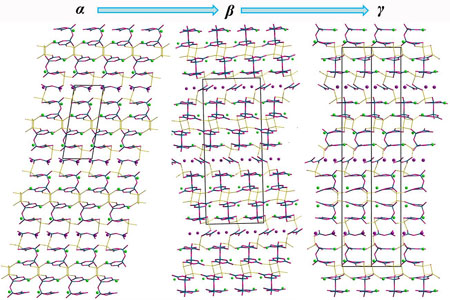Polar materials have attracted more attention due to their various functional properties including ferroelectricity, pyroelectricity, and nonlinear optical behavior, etc. The key to develop new polar materials is the understanding of how the polarity influences the functional property such as structure-property relationships. The current studies of structure-property relationships on polar materials focus on materials with similar structural motifs. However, the reports on the structure-property relationships of polar polymorphs are limited.
How to synthesize the polar structure efficiently and how to make the polar structure exhibit polymorphs are two problems in synthesizing polar polymorphs. There is a low possibility for inorganic materials to crystallize in polar space group in statistics.
Prof. PAN Shilie with his team from Xinjiang Technical Institute of Physics & Chemistry of Chinese Academy of Sciences and American scientists collaboratively synthesized three new polar Pb2Ba4Zn4B14O31 (PBZB) polymorphs by combining the flexible coordination Pb2+ cations with the variable zinc-borate framework. The polar polymorphs are referred to as α-, β- and γ-PBZB according to their crystallization temperature from low to high.
Researchers found that there were two types of asymmetric units in Pb2Ba4Zn4B14O31 polymorphs, the Pb2+ cations with a lone pair and Zn2+ cations with d10 electronic configuration. All of these polymorphs crystallized in the polar space groups. The three polymorphs contained two different constituent B-O groups including an isolated B2O5 dimer and a B6O13 group. The phenomenon that two different constituent B-O groups were contained in one structure did not follow the fifth rule of Pauling and was also rare in borates.
Based on the analysis of these structures and Brown’s determination, the phase transformation of Pb2Ba4Zn4B14O31 had been elucidated. The variable configuration and orientation of isolated B-O groups and the flexible coordination of the Pb atoms favored the phase transformation of Pb2Ba4Zn4B14O31. Besides, the theoretical calculations have been carried on the polar polymorphs.
The result has been published in Chem. Mater., which will be favorable for broadening the frontier field of polymorphism chemistry and enriching structure-property relationships in polar materials.
The work was financially supported by the Outstanding Young Scientists Project of Chinese Academy of Sciences, 973 Program of China, and the National Natural Science Foundation of China.

Figure: the crystal structures of (a) α-, (b) β- and (c) γ- Pb2Ba4Zn4B14O31 (Image by XTIPC
Contact:
Prof. PAN Shilie
E-mail:slpan@ms.xjb.ac.cn
Xinjiang Technical Institute of Physics & Chemistry,CAS
